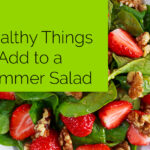A summer salad—it’s light, bright, and just right on a hot summer evening. The crisp lettuce and crunchy vegetables are refreshing, and with a little extra planning and a few added ingredients, you can pack even more nutrition and deliciousness while enjoying a truly satisfying meal.
Is a Salad Really Healthy?
The Dietary Guidelines for Americans 2020-20251 recommend eating at least five half-cup servings of vegetables a day, and let’s face it, a salad is an easy way to get at least a couple of those in.
Hearty green leaves like spring mix, baby kale, spinach, and arugula are the perfect building blocks for a healthy salad. By themselves, they are full of antioxidants and phytonutrients, but top them with more veggies like tomatoes and cucumbers and you are good to go, right? Well, not so fast! There are other ingredients that can bump up the nutrition significantly.
What are the Healthiest Things to Add to a Salad?
There are some ingredients that can pack in even more nutrition into this delicious meal. Here are five things to add to your summer salad to give it a nutritional boost.
Beans – Beans are a great source of plant protein and fiber. Cannellini or white beans, black beans, and soybeans (edamame) are delicious additions to any salad and work deliciously in a plant-forward diet. In addition to fiber and protein, they are a great source of B vitamins, iron, and many minerals like potassium.
Berries – Looking for a burst of sweetness and juiciness? Berries are the perfect addition to a summer salad. They add a bit of a fresh, bright flavor and pair wonderfully with sharp lettuces like baby kale and arugula.
Nuts – Healthy fats galore! These are full of more than just crunch. Walnuts are a good source of the omega-3 fatty acid alpha-linolenic acid that has been shown to reduce the risk of heart disease.2
Seafood – Want more healthy fats? Then seafood is your answer. Salmon, tuna, and swordfish contain DHA and EPA omega 3 fatty acids, which are important for heart health, brain, and eye health and helps to reduce inflammation. Fresh or canned seafood will work.
Dressing – Yes, salad dressing! The fat you get in the dressing helps your body absorb all those antioxidants from the vegetables in your salad. It can be as simple as extra virgin olive (great because it is full of healthy monounsaturated fats) and some balsamic or red wine vinegar, or a bottled dressing works as well. So, go ahead and add a little to coat those greens and add a flavor boost while you are at it.
Is There Anything You Should NOT Add to a Salad?
While all these things are great additions, calories and fat can add up quickly if you aren’t careful. Cheese, croutons, and bacon or other meats can all pack in extra calories and fat. Just remember, a little goes a long way. And while some dressing is good, keep the portion light. Stick with just a couple of tablespoons, and it’s best to keep the blue cheese and creamy dressings for special occasions. Toss your salad well before serving to make sure everything is coated, and you will get all the flavor you need. ν
1U.S. Department of Agriculture and U.S. Department of Health and Human Services. Dietary Guidelines for Americans, 2020-2025. 9th Edition. December 2020.
2Kris-Etherton PM. Walnuts decrease risk of cardiovascular disease: a summary of efficacy and biologic mechanisms. J Nutr. 2014 Apr;144(4 Suppl):547S-554S. doi: 10.3945/jn.113.182907. Epub 2014 Feb 5. PMID: 24500935.







